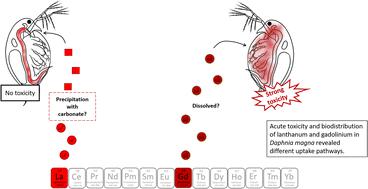当前位置:
X-MOL 学术
›
Environ. Sci.: Processes Impacts
›
论文详情
Our official English website, www.x-mol.net, welcomes your
feedback! (Note: you will need to create a separate account there.)
Determination of the distribution of rare earth elements La and Gd in Daphnia magna via micro and nano-SXRF imaging
Environmental Science: Processes & Impacts ( IF 4.3 ) Pub Date : 2023-05-25 , DOI: 10.1039/d3em00133d Marion Revel 1, 2 , Kadda Medjoubi 3 , Camille Rivard 3, 4 , Delphine Vantelon 3 , Andrew Hursthouse 2 , Susanne Heise 1
Environmental Science: Processes & Impacts ( IF 4.3 ) Pub Date : 2023-05-25 , DOI: 10.1039/d3em00133d Marion Revel 1, 2 , Kadda Medjoubi 3 , Camille Rivard 3, 4 , Delphine Vantelon 3 , Andrew Hursthouse 2 , Susanne Heise 1
Affiliation

|
While our awareness of the toxicity of rare earth elements to aquatic organisms increases, our understanding of their direct interaction and accumulation remains limited. This study describes the acute toxicity of lanthanum (La) and gadolinium (Gd) in Daphnia magna neonates and discusses potential modes of action on the basis of the respective patterns of biodistribution. Ecotoxicological bioassays for acute toxicity were conducted and dissolved metal concentrations at the end of the tests were determined. The results showed a significant difference in nominal EC50 (immobility) between La (>30 mg L−1) and Gd (13.93 (10.92 to 17.38) mg L−1). Daphnids that were then exposed to a concentration close to the determined EC50 of Gd (15 mg L−1, nominal concentration) for 48 h and 72 h were studied by synchrotron micro and nano-X-ray fluorescence to evaluate the biodistribution of potentially accumulated metals. X-ray fluorescence analyses showed that La was mainly found in the intestinal track and appeared to accumulate in the hindgut. This accumulation might be explained by the ingestion of solid La precipitates formed in the media. In contrast, Gd could only be detected in a small amount, if at all, in the intestinal tract, but was present at a much higher concentration in the tissues and became more pronounced with longer exposure time. The solubility of Gd is higher in the media used, leading to higher dissolved concentrations and uptake into tissue in ionic form via common metal transporting proteins. By studying La and Gd biodistribution in D. magna after an acute exposure, the present study has demonstrated that different uptake pathways of solid and dissolved metal species may lead to different accumulation patterns and toxicity.
中文翻译:

通过微米和纳米 SXRF 成像测定大型溞中稀土元素 La 和 Gd 的分布
虽然我们对稀土元素对水生生物的毒性的认识有所提高,但我们对其直接相互作用和积累的了解仍然有限。本研究描述了镧 (La) 和钆 (Gd) 对大型溞新生儿的急性毒性,并根据各自的生物分布模式讨论了潜在的作用模式。进行了急性毒性的生态毒理学生物测定,并测定了测试结束时溶解的金属浓度。结果显示,La (>30 mg L -1 ) 和 Gd (13.93 (10.92 至 17.38) mg L -1 )之间的标称 EC 50 (固定性)存在显着差异。然后将水蚤暴露于接近确定的Gd EC 50浓度(15 mg L -1,标称浓度)48 小时和 72 小时,通过同步加速器微米和纳米 X 射线荧光研究,以评估潜在的生物分布。积累的金属。X 射线荧光分析表明,La 主要存在于肠道中,并似乎在后肠中积累。这种积累可能是通过摄入介质中形成的固体 La 沉淀物来解释的。相比之下,Gd 在肠道中只能检测到少量(如果有的话),但在组织中的浓度要高得多,并且随着暴露时间的延长变得更加明显。Gd 在所用介质中的溶解度较高,导致溶解浓度较高,并通过常见金属转运蛋白以离子形式吸收到组织中。通过研究急性暴露后 La 和 Gd 在D. magna中的生物分布,本研究证明固体和溶解金属物质的不同吸收途径可能导致不同的积累模式和毒性。
更新日期:2023-05-30
中文翻译:

通过微米和纳米 SXRF 成像测定大型溞中稀土元素 La 和 Gd 的分布
虽然我们对稀土元素对水生生物的毒性的认识有所提高,但我们对其直接相互作用和积累的了解仍然有限。本研究描述了镧 (La) 和钆 (Gd) 对大型溞新生儿的急性毒性,并根据各自的生物分布模式讨论了潜在的作用模式。进行了急性毒性的生态毒理学生物测定,并测定了测试结束时溶解的金属浓度。结果显示,La (>30 mg L -1 ) 和 Gd (13.93 (10.92 至 17.38) mg L -1 )之间的标称 EC 50 (固定性)存在显着差异。然后将水蚤暴露于接近确定的Gd EC 50浓度(15 mg L -1,标称浓度)48 小时和 72 小时,通过同步加速器微米和纳米 X 射线荧光研究,以评估潜在的生物分布。积累的金属。X 射线荧光分析表明,La 主要存在于肠道中,并似乎在后肠中积累。这种积累可能是通过摄入介质中形成的固体 La 沉淀物来解释的。相比之下,Gd 在肠道中只能检测到少量(如果有的话),但在组织中的浓度要高得多,并且随着暴露时间的延长变得更加明显。Gd 在所用介质中的溶解度较高,导致溶解浓度较高,并通过常见金属转运蛋白以离子形式吸收到组织中。通过研究急性暴露后 La 和 Gd 在D. magna中的生物分布,本研究证明固体和溶解金属物质的不同吸收途径可能导致不同的积累模式和毒性。











































 京公网安备 11010802027423号
京公网安备 11010802027423号